Have you ever considered the complex relationships that exist inside your family? What impact might the experiences of your ancestors have had on your own life? How could behavioral patterns be inherited and passed down through the generations? Here's where genograms become useful.
A genogram isn't merely a family tree, however. It's a visual aid that explores the different dynamics and connections that hold a family together in addition to names and dates. In addition to mapping your family's genealogy, it provides a deeper insight into your identity and origins by mapping their emotional, psychological, and even physical histories.
So, let's go off on this journey together. Get ready to be surprised by the tales your ancestors have to share and be equipped to add your special thread to the fabric of your family history.
What is a Genogram?
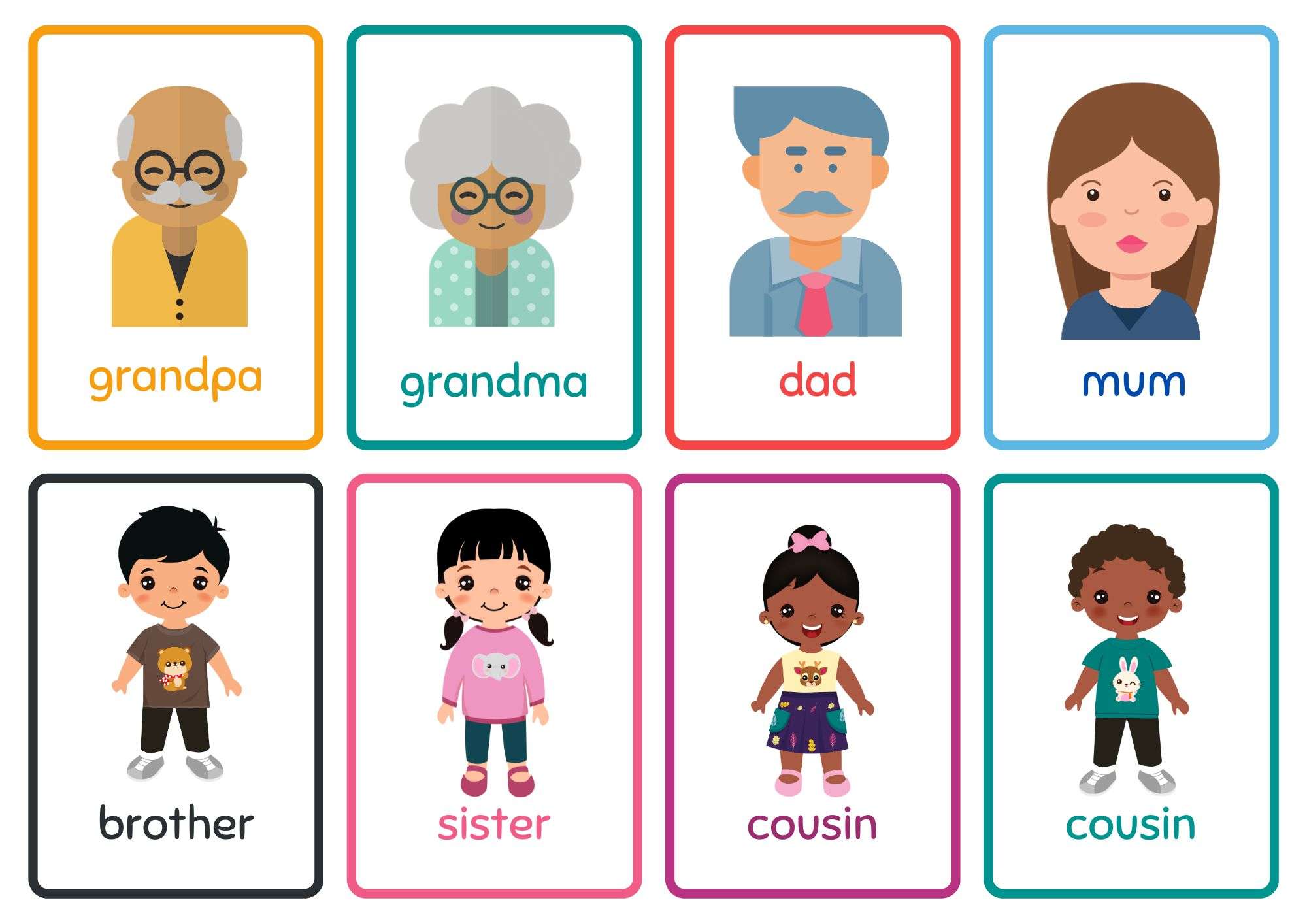
A genogram represents the relationships and background of an individual's family. It goes beyond a conventional family tree, enabling the creators to see psychological variables and patterns that influence relationships.
First created by Monica McGoldrick and Randy Gerson in clinical psychology and therapeutic family settings, genograms gained widespread recognition in 1985 with the release of the book Genograms: Assessment and Intervention. The customer was shown in this new system with other family members, such as grandparents, parents, partners, siblings, kids, nephews, and nieces.
Nowadays, different groups of individuals use genograms in a range of sectors, including education, youth work, psychiatry, social work, medicine, and genetic research, to mention a few.
Professionals in social work frequently use genograms and sociograms in personal and family therapy to help clients understand family dynamics and maintain personal records.
Want to make a genogram yourself? Download Wondershare EdrawMax or try the free tool online.
In this article
Part 1. When to Use Genograms?
Genograms are effective tools that can be used to comprehend family dynamics, spot trends through the generations, and learn more about the health and behavior of a person.
However, when precisely should you think about using one? The following are some important situations in which a genogram can be especially useful:
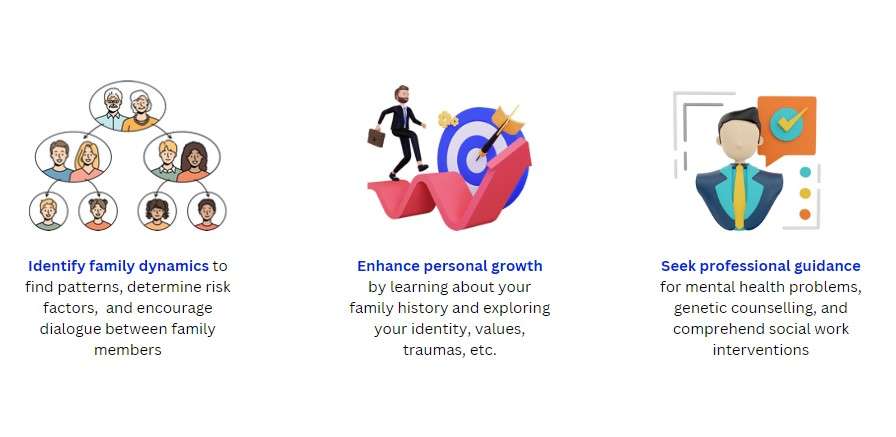
1. Recognizing the Dynamics of Families
- Find patterns: Show how connections, behavior, and health vary through the generations. These trends can forecast future events and explain present difficulties.
- Determine the risk factors: By mapping family medical history, determining possible genetic predispositions to diseases will allow for early intervention and preventative actions.
- Encourage dialogue: Use a genogram as a starting point for frank discussions about challenging subjects to advance knowledge and cultivate wholesome relationships.
2. Enhancing Personal Growth
- Learn about yourself: Explore your family history to learn more about your identity, values, and habits and become more self-aware.
- Recover from trauma: Gain perspective and start the healing process by processing past events and their effects on the family.
- Develop resiliency: Recognize the advantages and disadvantages of your family to help you better handle life's obstacles and adjust to change.
3. Seeking Professional Guidance
- Mental health assessment: By examining family dynamics and determining possible causes of mental health problems, therapists create efficient treatment programs.
- Genetic counselling: Examine the family medical history and provide information on possible risks and guardianship strategies for genetic illnesses.
- Social work interventions: Create specialized interventions by comprehending the intricate dynamics of families dealing with issues like abuse, neglect, or poverty.
Part 2. Different Types of Genograms
A genogram is more than just a family tree; it is a detailed diagram that weaves together generations of family history. They visually represent relationships, family dynamics, and even past medical conditions. However, genograms come in various types, each concentrating on a different aspect of family life.
1. Family Genogram
Image Name: what-is-a-genogram-03
Alt-text: Create family genogram with edrawmax
This is the most common type of genogram, focusing on basic family structure and relationships. It includes information such as:
- Names and dates of birth and death.
- Marriage and divorce dates.
- Relationships between family members (parents, children, siblings, spouses).
- Gender of individuals (represented by symbols).
2. Emotional Relationship Genogram
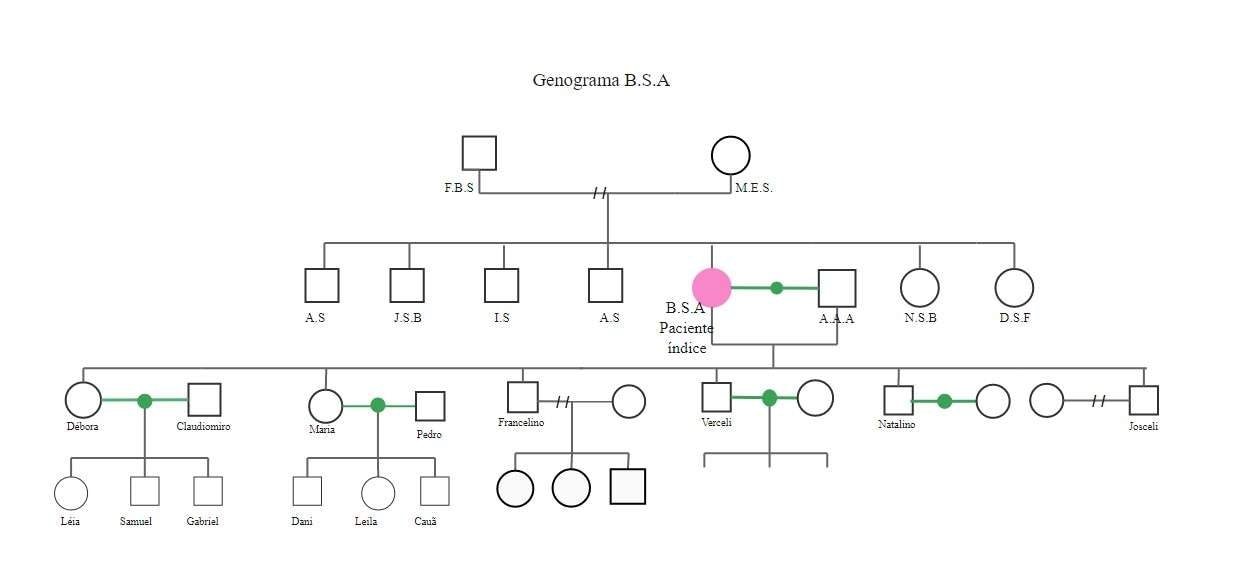
This type of genogram delves deeper into the emotional dynamics of the family. It can include information such as:
- Emotional quality of relationships (loving, distant, conflicted).
- Major life events and stressors (trauma, abuse, loss).
- Emotional patterns and challenges within the family.
- Emotional health of individuals (depression, anxiety, substance abuse).
3. Relationship Genogram
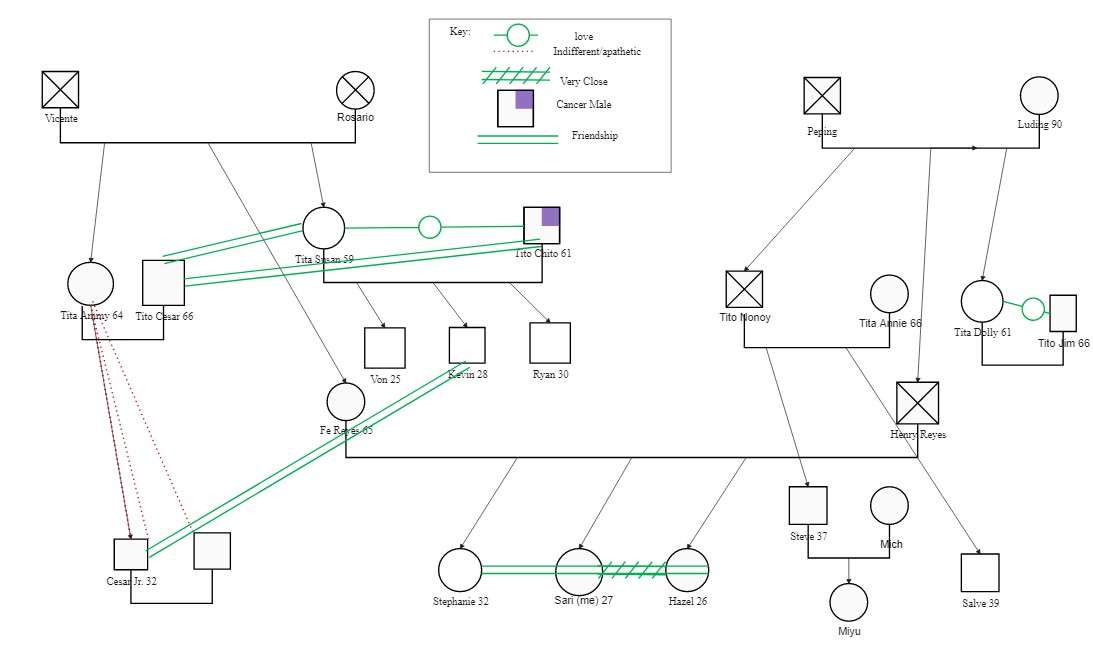
This genogram focuses specifically on the relationships between different family members. It can include information such as:
- Strength and quality of individual relationships.
- Patterns of conflict and resolution.
- Communication styles and dynamics.
- Support systems and social networks.
4. Medical Genogram
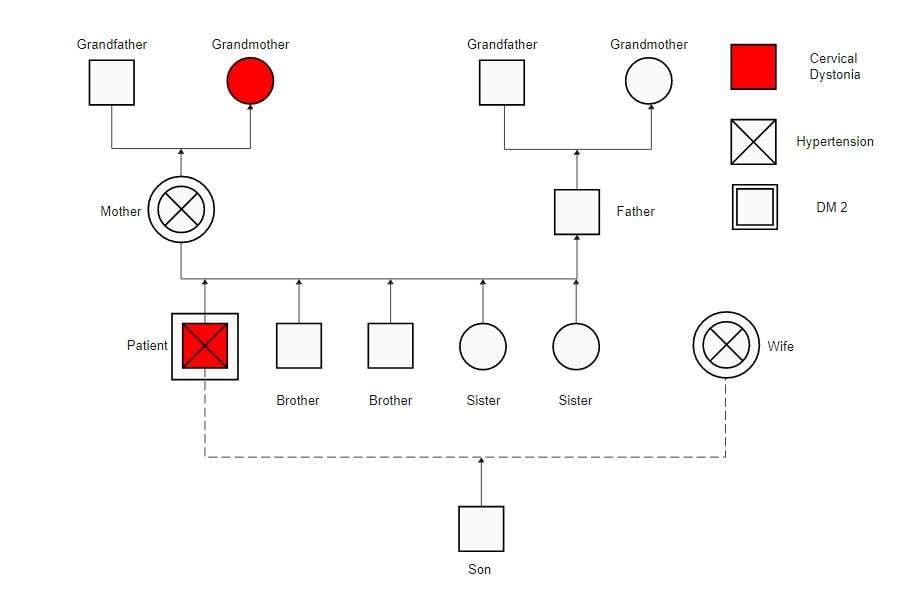
This type of genogram is used to track medical history within a family. It can include information such as:
- Family history of specific diseases (cancer, heart disease, mental illness).
- Causes of death.
- Genetic testing results.
- Ongoing medical conditions.
Part 3. Genogram Symbols
Genograms describe people, connections, and other information using a set of standard symbols. It is essential to comprehend these symbols to interpret and create your genogram. The most typical symbols are broken down as follows:
People
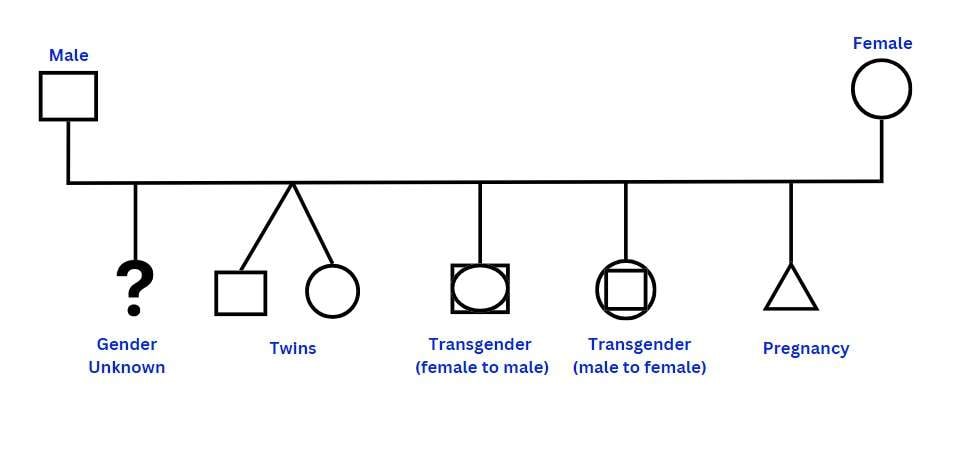
- Male: A square stands for a person who is male.
- Female: The symbol for a female person is a circle.
- Gender unknown: An unidentified person's gender is symbolized by a question mark.
- Twins: Twins are represented by two connected squares or circles. A horizontal band linking the symbols denotes identical twins or fraternal twins.
- Transgender (female to male): A square with a triangle inside represents an individual assigned female at birth but identifies as male.
- Transgender (male to female): A circle with a cross inside represents an individual assigned male at birth but identifies as female.
- Pregnancy: A triangle with the point facing down indicates a pregnancy.
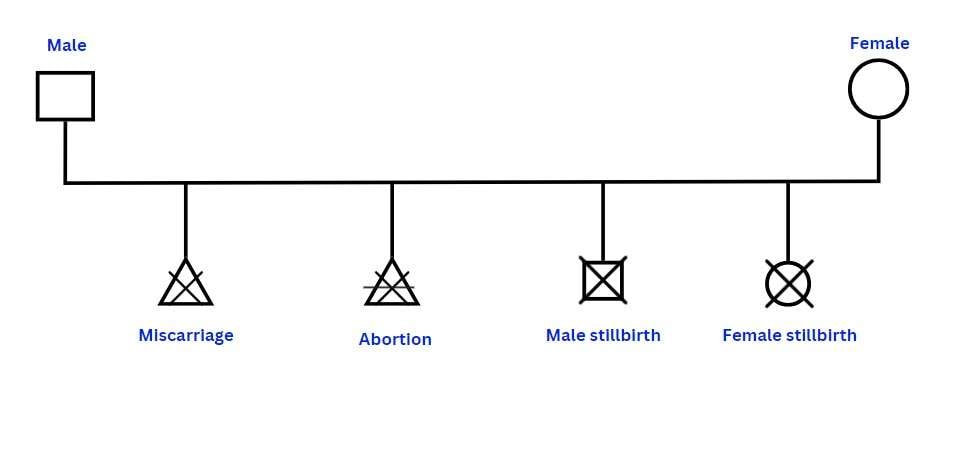
- Miscarriage: A triangle with a dashed line through it means the loss of a pregnancy before the 20th week. It can be a significant event in a family's history.
- Abortion: A triangle with a diagonal line through it signifies deliberate termination of a pregnancy. It's important to approach this symbol with sensitivity, as it may represent complex emotions within a family.
- Male stillbirth: A square with a diagonal line through it shows the tragic event of the death of a male baby before or during childbirth.
- Female stillbirth: A circle with a diagonal line through it represents the death of a female baby before or during childbirth.
Relationships
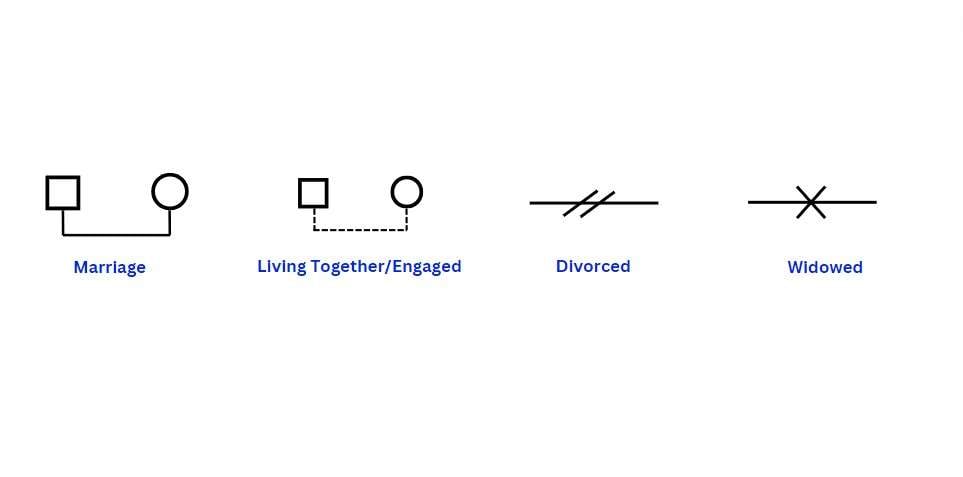
- Marriage: A marriage is symbolized as a single line joining two people.
- Engaged: A relationship in which two people cohabit is indicated by a dashed line connecting them.
- Divorce or Separation: Two slashes across the marital line indicate divorce or separation.
- Widowed: It is represented by a square with a diagonal line which signifies the end of the marital relationship due to the death of the spouse.
Part 4. Genogram Examples
Those complex family history charts called genograms can provide fascinating new perspectives on individual lives, family relationships, and health trends. To demonstrate the variety of uses for genograms, consider the following examples from the templates community of Wondershare EdrawMax.
Career Genogram

This genogram charts several generations' educational backgrounds and job pursuits within a family. It can show patterns of career influences, educational attainment trends, and family business traditions passed down through the generations.
Cultural Genogram
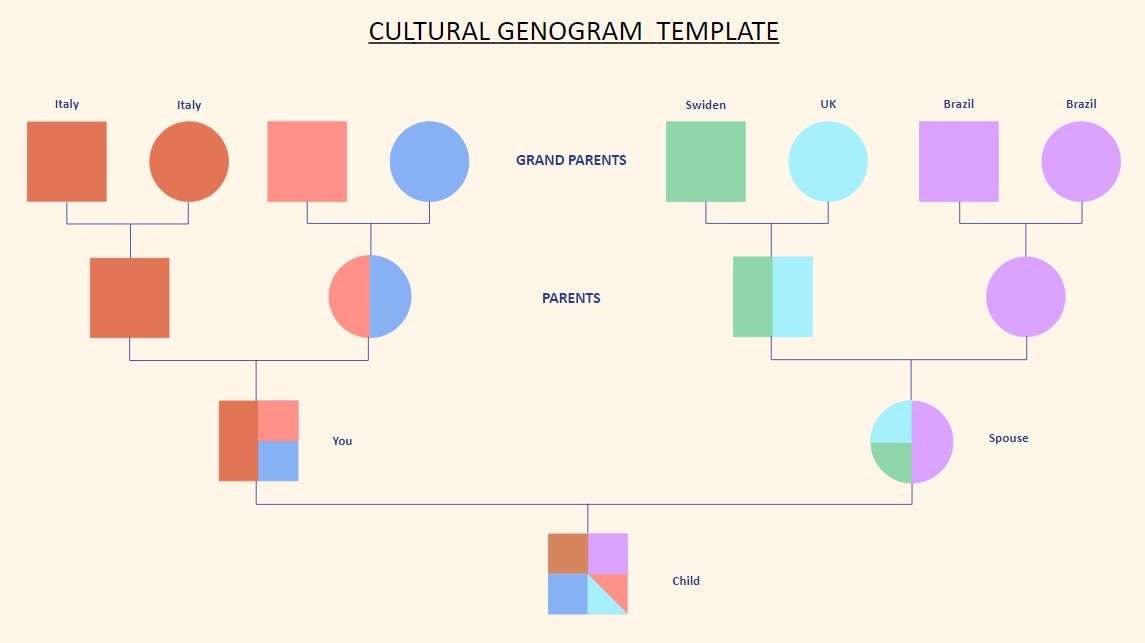
This genogram explores the customs and cultural history of a family. It may contain details on ethnicity, religion, spoken language, and cultural values. Understanding these cultural influences can help one get important insights into personal identity and family relations.
Health History Genogram
This genogram charts the lineage of particular illnesses, long-term ailments, and health hazards. It can guide family planning decisions, detect genetic predispositions, and inform preventative healthcare interventions.
Hemophilia Genogram
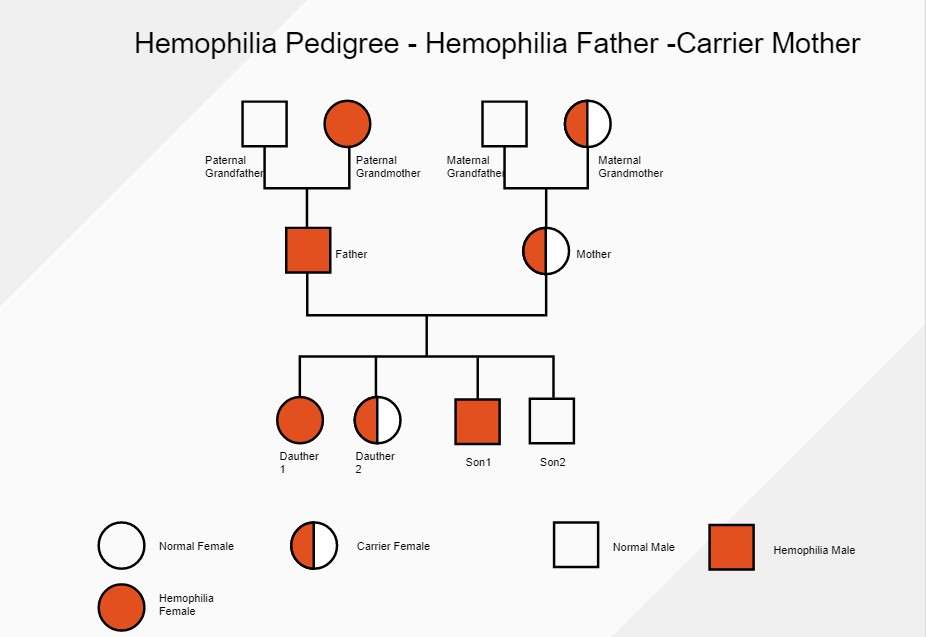
The inheritance of X-linked recessive disorders, such as hemophilia, is monitored using this genogram. It uses certain symbols to represent carriers, afflicted people, and departed family members. This information may be essential for family planning, genetic counseling, and medical illness management.
How to Interpret a Genogram?
Genograms weave together generations of people, relationships, and experiences to provide a graphic depiction of family history. However, merely glancing at a genogram is insufficient. The true strength is in deciphering its data and drawing insightful conclusions.
Here is a guide to help you discover the mysteries concealed in your family's history:
1. Identify Key Elements
- People: Take special note of the symbols employed to symbolize people, their gender, and their interpersonal connections.
- Dates: Knowing a person's birth, death, and marriage dates is crucial to comprehending life events and family dynamics.
- Lines: Examine the connections between people to determine the type of relationships they have (spouse, parent-child, sibling, etc.).
- Annotations: Look for extra notes or symbols that denote certain incidents, medical conditions, or other pertinent details.
2. Look for Patterns
- Recurring Relationships: Consider the family's general composition. Exist any trends about early marriage, divorce, big families, or homes with only one parent?
- Health History: Look for indications that a certain disease or set of health issues runs in the family.
- Emotional Dynamics: Examine the annotations and line styles to find conflict patterns, communication philosophies, and emotional health.
- Cultural Influences: Research the religion, customs, and cultural history that may impact family dynamics and personal identities.
3. Analyze Individual Lives
- Contextualize individual experiences: Consider each individual's position within the genogram and how family events and dynamics may have shaped their lives.
- Determine any possible risks: Utilize the genogram to pinpoint any environmental or genetic variables that may impact a person's health or well-being.
- Assess your advantages and disadvantages: Look for trends in the person's family history that could provide information about their coping strategies, shortcomings, and strong points.
4. Consider the Broader Context
- Social factors: Look into the family's employment history, educational background, and social standing.
- Historical context: Consider significant historical occurrences that may have affected the family and its members.
- Cultural values: Examine the family's cultural heritage and its potential effects on their customs, beliefs, and behaviors.
5. Engage in Dialogue
- Talk about your interpretations: Talk to family members about your observations to get their opinions and complete any lacking details.
- Seek expert advice: Consider speaking with a therapist, counselor, or geneticist if you have questions concerning particular patterns or your well-being.
Part 5. How To Make a Genogram?
Here's a detailed tutorial on creating a genogram:

Step 1: Gather information like names, birthdates, marriages, divorces, deaths, and noteworthy incidents or health issues. Speaking with family members or looking through family documents is beneficial to ensure accuracy.
Step 2: Define symbols for family relationships; squares for men, circles for women, lines to show partnerships, and various line kinds to indicate the sort of relationship (e.g., solid for marriages, dashed for divorces) are common symbols.
Step 3: Use a large piece of paper or a genogram software tool to make your genogram. Working your way down, begin with the oldest generation at the top and connect the family members.
Step 4: To represent individuals, add symbols to the genogram. To depict partnerships, use squares for men and circles for women, with lines connecting them. Add more symbols to represent offspring, siblings, marriages, and divorces.
Step 5: Provide extra information, such as dates of birth and death, significant life events, and health issues. Symbols such as a diagonal line through a square or circle denote a deceased person.
Step 6: Label each generation to give a clear picture of the family structure. Each succeeding generation is often displayed below the oldest, which sits at the top.
Step 7: Review the genogram with your family to ensure accuracy. Updates and revisions to the genogram might be necessary if new information becomes available or family dynamics shift.
Conclusion
Genograms are powerful tools that provide a comprehensive and insightful look into the intricate dynamics of family relationships. As we've explored in this guide, they allow us to explore hidden stories, understand behavioral patterns, and uncover the impact of our ancestors on our lives. The creation and analysis of genograms is a journey that enables individuals to explore their family history, promoting understanding, resilience, and a deeper sense of self.
[没有发现file]



